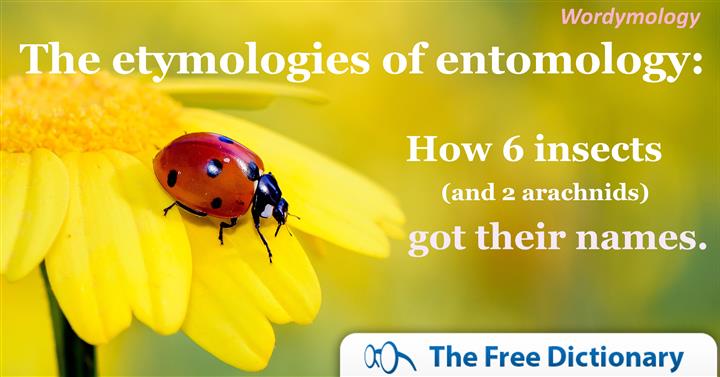The Etymologies of Entomology.

Don’t bug out—today, we’re exploring the etymologies of entomology, a.k.a. the scientific study of insects. If you’re wondering why “entomology” and “etymology” sound so similar despite having wildly different meanings, well, we have the ancient Greeks to thank for that. “Entomology” has as its root entomon, which is the Greek word for "insect,” while “etymology” comes from etumon, which means “true sense of a word.” Those two letters make a world of difference in meaning!
If you have the learning bug, keep reading to find out how six insects (and a couple arachnids) got their names.
Snug as a Ladybug in a Rug
Is this family of small, colorful beetles named for a real lady? Yes, the Virgin Mary, who is commonly called “Our Lady.” Ladybugs (or “ladybirds” in British English) are believed to have been christened with this name in the Middle Ages, possibly because the seven spots found on the species most common in Europe were interpreted as symbolic of the Virgin Mary’s seven joys and seven sorrows. That takes care of the “lady” part of this name, but what about “bird”? Well, it seems the insect was originally referred to as “Our Lady’s bird,” which ended up being shortened to “ladybird.” So “bird” may just be a fancy misnomer, but “bug” actually isn’t totally accurate either, as entomologists separate beetles from what they call “true bugs”—insects with piercing or sucking mouthparts. (Eek!)
Rooster Roaches and Hairy Cats
The word “cockroach” comes from the Spanish word cucaracha, whose origin is uncertain. English adventurer John Smith alluded to this word when he wrote of a “cacarootch” in the 17th century, though his spelling was possibly influenced by “caca,” another word for excrement. Later English speakers brought the rooster into the equation (why, we’re not sure), and this is how we ended up with the “cockroach.” In reality, the cockroach’s etymological cousin is the caterpillar, known as the cuca in Spanish.

Caterpillars, meanwhile, have their own puzzling etymology. They could technically celebrate Caturday, as their English name comes from the Old North French word catepelose, which literally means “hairy cat,” most likely in reference to the hair-like bristles (called “setae”) found in some species. But why cats (as opposed to some other hairy animal) wormed their way into the etymology isn’t exactly clear.
Butter(fly) Me Up

Although caterpillars and butterflies belong to the same order of insects, Lepidoptera (caterpillars are just the larval stages of butterflies, after all), the origin of the name “butterfly” is quite different to that of its juvenile form. Instead of Old French, this name comes courtesy of Old English—buttorflēoge. Though the significance of the name is not known for sure, it might have been used because people believed that butterflies stole butter and milk. (Butor means “butter,” while flēoge means “fly,” as in, the insect.)
Like a Pray-er

The praying mantis is really the praying seer or praying prophet—those are the meanings of the Greek word mantis. The mantis’s association with prayer comes from its tendency to hold its front legs in a pose similar to someone praying. It is also possible that the mantis was once considered to have powers related to divination.
The Itsy Bitsy Spider (and Tarantula)

We know, we know—spiders aren’t insects! Technically, these guys have their own field of study known as “arachnology,” but we’re including them here because their etymologies really have legs. (Besides, spiders certainly bug plenty of people, har har.)
“Arachnid” comes from the word arakhnē, which means “spider” in Greek. Coincidentally, this word also gave the Greek goddess Arachne her name. (She was transformed into a spider for defeating Athena in a weaving contest. Do not want.)
Meanwhile, the tangled web the spider weaves factors into its name. “Spider” comes from the Old English word spīthra and is related to the Danish word spinder, both of which are related to the Middle English word “spinnen”—to form thread or yarn from fibers.
“Cobweb” is another webby word that refers to the spider. It comes from the Middle English word coppeweb, in which coppe means “spider.”
Tarantulas, though, dance to a different tune. These large spiders are named for Taranto, Italy, where their bite was once thought to be the source of tarantism, a mania common between the 15th and 17th centuries that, believe it or not, was accompanied by an uncontrollable urge to dance.
Wigging out
Earwigs may have the creepiest etymology of all these creepy-crawlies. They get their name from the Old English word ēarwicga, which literally means—UGH—“ear insect.” Their name is popularly thought to come from a superstitious (but thankfully false) belief that earwigs would wiggle their way into human ears and burrow into people’s brains while they slept. Now, don’t worry, even if an earwig somehow does get into your ear, it apparently can’t travel past the eardrum. (Yay?) But this bygone ear-ie belief remains etched in the earwig’s name to this day.
Now, hit those share buttons below and go bug your friends with these etymologies of entomology!
Get all volumes of The Farlex Grammar Book in paperback or eBook.

